I’ve been cooking Southern food since I was seven years old and my grandmother taught me to pan-fry catfish. I won’t lie to you; Southern food, when made properly, is very very bad for you.
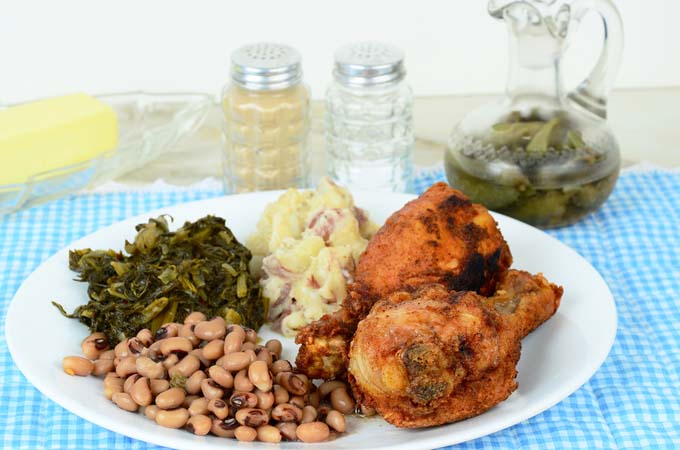
But it’s also some of the tastiest food you’ll ever have, and if you don’t eat it every single day, it’s not going to clog your arteries right away.
Basics of Southern Cooking
Southern cooking is known for its use of lard and salt. Southern cooks north of Louisiana don’t use too much sugar; it wasn’t easily available when this style of cooking was developed.
Instead, food is sweetened with fruit or molasses. In the rare case that you need sugar, brown sugar is used much more often than refined sugar.
To do things right, you’ll have to have at least one cast-iron skillet, preferably two. These frying pans should be well-cured with bacon grease (traditional) or a high smoke point oil such a coconut.
In your cabinet of Southern staples, you’ll need: salt, pepper, buttermilk, butter and/or shortening, all-purpose flour (not self-rising), baking soda AND baking powder, corn meal, and for Cajun-style cooking Cajun spice. It’s nice to have cayenne pepper as well if you’re a spice lover.
Typical Southern Vegetables and Meats
Staple vegetables include green onions, greens, cabbage, potatoes, carrots, tomatoes, sweet potatoes, and in some areas okra and black-eye peas.
Perhaps because so many Southerners have Irish ancestry, the most common staple veggie is potato – fried, boiled, baked, or stewed. Cabbage, collard greens, carrots, and black-eye peas are generally boiled, often with butter and usually with salt and pepper. Green onions are eaten whole and raw, as are red tomatoes.
Okra and potatoes are commonly deep-fried, and green tomatoes also are breaded and fried. Breading is commonly done by dipping the vegetable in buttermilk, then rolling it in lightly-spiced cornmeal.
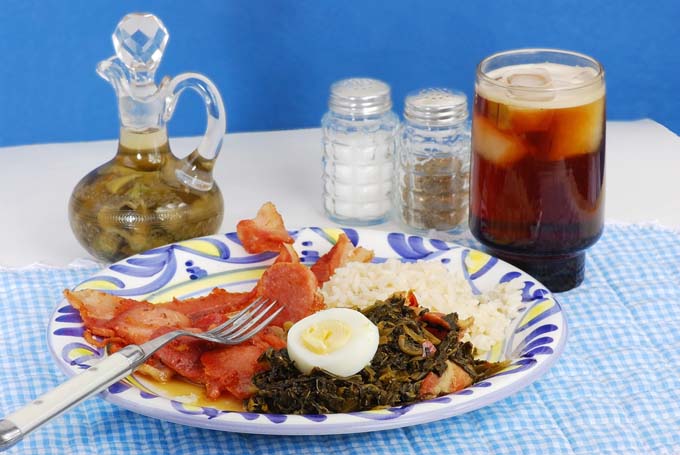
One of the hallmarks of Southern cooking is its use of cheap, plentiful, and often cast-off parts of animals and plants. Turnip greens, for instance, are boiled and eaten with vinegar, or blended in with pork or potatoes. You can really see this tendency in the choice of meats.
Pork is possibly the most common source of meat: bacon, ham, ham hocks, pigs feet, pork chops (try our honey mustard pork chop recipe!), sausages. Every part of the pig is used, from the face, in souse or head cheese, to the intestines, in chitlins or sausage casings.
Or as the old timers used to say – “everything but the squeal.” Today, most Southern cooks prefer hams and aged meats from the pig as opposed to the more gross parts like the feet or intestines, but you still find all of it being used.
Chicken is the other very common meat choice, mostly because like pigs all you have to do to raise chickens is turn them out and let them fend for themselves (unless you have a lot of hawks and/or owls around).
 In wetter states, you’ll find a lot of seafood. Catfish is ubiquitous, and is always breaded and fried. Crawfish, found throughout all the river and creek systems in the South, are eaten primarily in Louisiana and up the Mississippi River basin.
In wetter states, you’ll find a lot of seafood. Catfish is ubiquitous, and is always breaded and fried. Crawfish, found throughout all the river and creek systems in the South, are eaten primarily in Louisiana and up the Mississippi River basin.
They’re boiled whole in large pots and then eaten either by sucking the meat out the neck after breaking off the head, or by shelling out the meat and using it in other dishes.
Snapping turtles, if you boil them long enough, make a pretty good soup, and just about any other water critter you can find in the South has made its way into a dish at some point.
“Critters” are commonly eaten out in the country. Venison from deer is probably the most common wild game eaten, and though you won’t find it in a restaurant, every Southern family has its own recipe for venison chili, stew, or burgoo.
Squirrel and rabbit are fried or stewed.
You’ll find everything else eaten, from armadillo in the deep South to possum all over the region.
Southern Variations
There are five basic regions in the South as far as cooking goes: the Appalachians, the Atlantic and Gulf Coast, Louisiana and the Mississippi Delta, Texas, and then the Alabama-Mississippi region. Each area’s foods are based mostly on what was widely available in the region.
The most famous Southern variations are from Louisiana: Cajun and Creole foods. Both these types were heavily influenced by French and Spanish cuisine, so you’ll find a lot of spices and cream-based sauces here.
Creole foods are more French, as this style was developed by a wealthier class of people who were able to afford saffron, cream, and other expensive ingredients.
Cajun cooking is much more exciting. This style was developed by the French Acadians, who first settled in Canada before the British resettled them in Louisiana.
It’s a style of food based on whatever they could find to eat, and is also heavily spiced with four key spices: red pepper, onion, celery, and garlic — not much salt. Almost everything tastes good with Cajun seasoning – french fries (or our oven-baked green bean fries!), hamburgers, potato salad, you name it.
Most other Southern cuisines are the same as what African Americans call “soul food” – fried chicken, fried potatoes, fried green tomatoes, fried fish – you see a trend? — and things like greens with vinegar, snap beans, and corn bread baked in a cast-iron skillet.
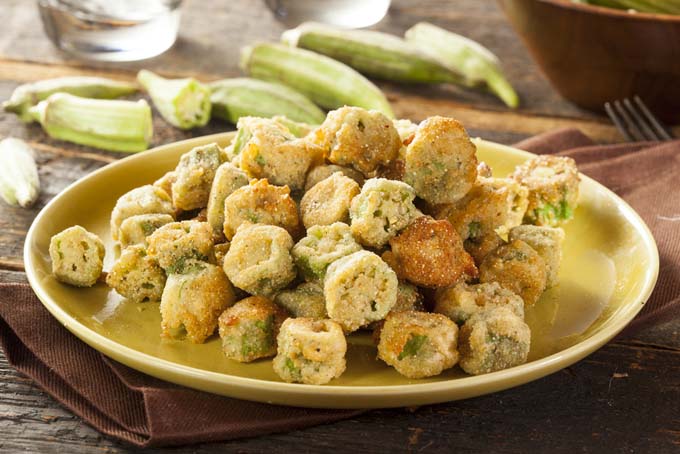
A plate of tasty fried okra – is it Southern or Soul food or both?
Southern Similarities – And Making It Healthier
All Southern cuisine has one thing in common: its adherence to the primary Southern food groups. That would be fried, salted, cured, and sometimes boiled. Steamed veggies have no place here.
But there are ways to make it healthier. Sure, you lose a little of that home-style flavor. But you get to add a few years to your life to enjoy it.
Every real Southern meal must be served with sweet tea (said as one word: sweetea). That’s what a Southerner is really asking for when he says “ice tea.” You can make surprisingly good sweet tea by using baking-formulated Splenda as a substitute for regular sugar.
You’ll need to experiment around to get just the right mix for you, but I do: a gallon of boiling water poured over six family-size teabags, left to steep for 15 minutes, and then a heaping cup of baking Splenda (1:1 sweetness ratio compared to sugar – for heaven’s sake don’t use Splenda in those little packets!) mixed in well.
My husband prefers a cup and a half of Splenda or a little more. Either way, end result- zero-calorie sweet tea that tastes almost identical to the real thing.
All them things you usually bread and fry? Oven-fry them instead. Bread by first dipping the meat or veggie in a 1:1 egg/buttermilk blend, then dipping in a blend of bread crumbs, corn meal, and seasoning. Lay your breaded pieces in a single layer on a pan, and refrigerate for 1-2 hours. This gets the breading to set well.
Next, spray down a cured cast-iron skillet with Pam or a substitute. Put your breaded pieces in the pan in a single layer, and put just a dab of congealed bacon grease, butter, or lard on top (yes, they’re bad for you, but they also give a unique flavor to your food). Bake at 375°F until the tops are browning, then flip each piece and bake for at least another ten minutes.
Use your common sense: tomatoes don’t need to bake as long as chicken! Look up safe baking times and temperatures for all your meats. Note: if the dab-of-stuff was too gross for you, put a slice of bacon in the bottom of the pan before baking your food; it’ll do almost as good a job.
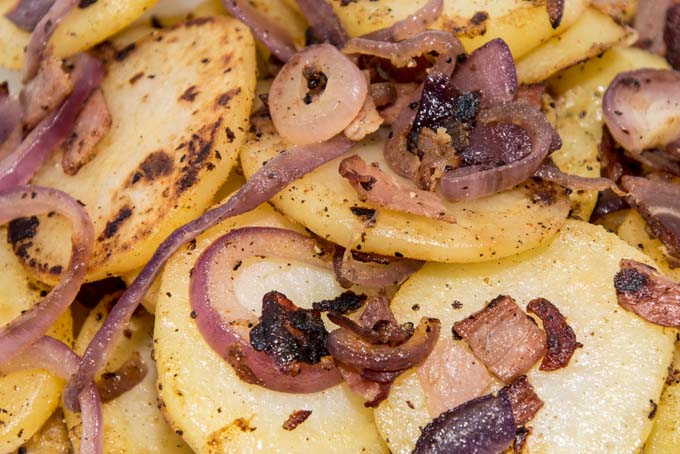
Oven roasted/fried potatoes make an excellent substitute for pan or deep fried
Fried taters are more problematic; baked, they just taste awful. Try this: cut your potatoes in thin slices instead of sticks, and blend in a thin-sliced onion for each two pounds of potatoes.
Put them in a freezer bag and freeze for 24 hours. This completely changes the cellular makeup of starchy veggies.
Take them out when you’re ready to cook and put them in an oil-sprayed nonstick skillet in a layer no more than about an inch thick. Salt and pepper to taste, then cover and fry at medium-low heat for about ten minutes.
Turn up the heat to medium-high for about five minutes, uncover, and flip. They should be nice and brown on the bottom; if not, cover and cook a few more minutes.
Fry flipped potatoes for about five more minutes and then serve.
Don’t make more than you’ll eat; they don’t keep very well this way. (If your potatoes are sticking, put about an eighth of a cup of water in with them when you start frying.)
If you’re trying to cut back on salt, use Cajun seasoning instead. It’s a little spicier, but it gives you a LOT of flavor without a lot of sodium. Look for Cajun seasoning that leaves out the salt. Also, season more with onion and garlic.
Go ahead and use butter instead of margarine. Science is finding more and more that either one is as bad for you as the other, and butter cooks and tastes better.
The exception: the margarines that are made with Omega-3 and Omega-6. If you have a cholesterol problem, use these instead.
Try the steamed veggies. I like to blend broccoli and carrots with Southern vegetables: snap beans, potatoes, even black-eye peas. The exception: okra is horrible steamed. Just don’t do it.
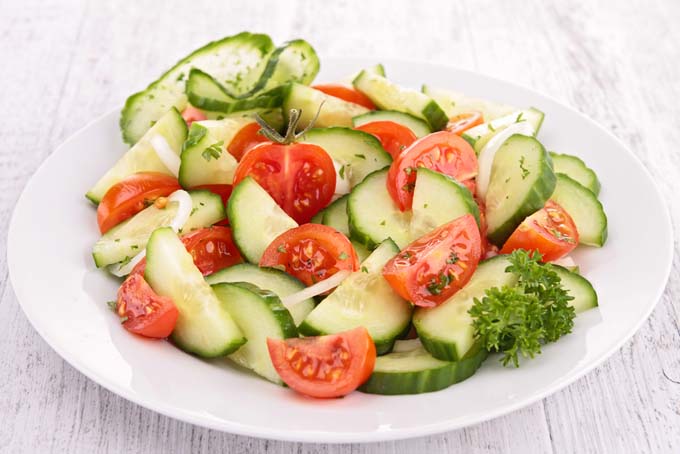
Eat more fresh vegetables and fewer cooked meats. For instance, Southern tradition is huge on fresh raw tomatoes, cucumbers, and green onions. Load up the table with these goodies.
Southern tradition is also huge on cured pork products: hams, salt pork, bacon, ham hocks, etc.
Eat hams that are honey-cured, not salt-cured, and try to use any other cured pork as a seasoning for other dishes, not as a main dish.
For instance, salt pork or jowl bacon is a perfect seasoning when boiled with butterbeans, and doesn’t add too much salt or fat to the dish if you avoid eating the hunk of meat that’s left in there.
About Lynne Jaques
Lynne is a stay-at-home mother of two boys. As a former US military officer and the spouse of an active duty US military member, Lynne enjoys traveling the world (although not the moving part!) and finding new cuisine and methods of preparing food. She also has the habit of using parenthesis way too much!




Southern food is so delicious, but so bad for you. I guess that is the way with all the things that taste great. It’s wonderful that we have all of these healthy alternatives to authentic southern recipes, but we also have to admit that it is not quite the same. If margarine and butter are just as bad then I will definitely go with butter instead 🙂
I don’t use either very often, but butter will definitely add more flavor to my dishes so I will use it from time to time.
I love southern style cooking too but have always been mindful of its content and not eaten it often. Good to see some healthy variations here giving us some options and ideas. I could eat steamed broccoli all day, there is something so alluring about the taste.
I grew up eating southern food so I still crave it every once in a while. I’d prefer to eat it sparingly and go all in on the fat 🙂 There’s nothing like a plate of fried catfish with hush puppies and okra. I’m going to try your frozen potatoes trick–I’m always looking for new ways to prepare them. Thank you.
Fried potatoes with onions, black eyed peas, fried chicken, COLLARD greens! Whew!! Be still my beating heart. I grew up eating this type of food, only we didn’t call it southern style cooking, we just called it cooking, lol.
My mom cooked like this almost every day, but she also had tons of fresh vegetables and fruit available too. Our diet was well rounded. I considered her cooking to be healthy because of all the vegetables that she always made available daily.
I didn’t appreciate this type of cooking until I moved out of my parents house and away from my mom and dad’s cooking. It definitely has to be eaten in moderation. I don’t eat pork, so that helps a lot.
Fascinating – thank you. I didn’t know there was so much variety in Southern cooking, nor did I expect some of the vegetables you mentioned – the fried bit I did know though!
I like the frozen potatoes idea so I might just try that. One thing I do love out camping is frying potatoes, capsicum, onion and mushrooms – such beautiful flavours! I think taking a frozen bag of potatoes would be a great way to do that dish, too.
Thank you for the quick warning although i must say, those dishes look inviting, if one only knew the ingredients within one might pass or just cave in, but like you’ve said indulging once in awhile won’t hurt. Now on the other hand, raw veggies and fruits and am all in any-day 😉
You have certainly brought back some wonderful memories with this article. I was born and raised on a farm in Georgia, and have had so many of the great dishes that you mentioned. Every day of the summer we had a plate of raw green onions, cucumbers soaking in vinegar, and sliced tomatoes on the table. Squash, eggplant, and okra were almost always breaded in cornmeal and fried, and the collards were cooked with fatback. I have collards for supper tonight, but they are cooked in olive oil, and they don’t taste southern at all!
I’ve got collards on the stove right now as well, but mine are cooking with bacon and a little bit of cured ham. I was born and still live in Georgia so this all just sounds like food to me. We do try to make our favorites in healthier ways though 99% of the time.
Southern style food is one of the most difficult cuisines to make healthier. With all the fried food, butter & cream it’s a wonder people aren’t having heart attacks left & right. I love these suggestions. I’m always for making great food better through healthy changes.
Thanks for the great advice & suggestions; I’ve often considered whether I could oven bake things I would usually fry but didn’t know where to start, so that’s a great help.
Cajun seasoning is great for cutting back on salt; I add it to dishes like fish stew to up the flavour without the calories, but I find that it’s definitely worth buying the individual component spices and adding it yourself; the blends the shops sell always seem to include salt high up the ingredients list.
It sounds like you had been peeking in my grandma’s kitchen back in the day. She made all of this and then some. I remember her always having a glass filled with green onion stalks on the table during family meals. It’s like the southern substitute for a relish tray.
I often make a fresh vegetable salad that looks like one of your pictures, with tomato, cucumber, onion, and I also add bell peppers. It’s so tasty and refreshing.
I usually oven fry my taters these days. I cut them up, toss them with a bit of olive oil and pop them into the preheated oven. I usually start them with the broiler on then switch over to regular, so they cook evenly on both sides, without having to turn them constantly.
Nice foods overall. Southern style cooking typically has that ‘home-style’ feel to it; it’s more personal and hearty. It’s good food to try once in a while but I wouldn’t want to get tempted if I’m on a strict diet and aiming for weight loss.
I am from Texas, however, southern style cooking doesn’t appeal to me. That plate however looks great. I guess it’s the first time I ever saw a plate with any kind of greens and black eyed peas on it and there wasn’t the juices everywhere. I think that’s why I don’t like southern cooking. Hmm, this gives me a whole new perspective though.
I like this post. It takes me back to my childhood. I actually didn’t know it was southern influence. We always ate green onions with meals;especially collard greens, and they were deliciously cooked with vinegar. I cook them the same now. I especially like your revelations on seasons used in Cajun cooking and on the breading process. I will definitely be using the refrigeration part of to process to enhance my foods. I may have to miss out on some familiar flavors, since I am vegan, but the southern vibe is a part of me and this helps me keep it alive. Thanks!
Thanks for a great article, i am based in the UK but i am fascinated to learn about the southern USA style of cooking. My main culinary interests have always been in Chinese and Indian cooking partly because of the rich history associated with the food. This is also the case with southern cooking and i am almost as interested in learning about the origins of the cooking as i am in the food itself. There are also regional variations to the cuisine as with Chinese and Indian which creates further interest.
I am particularly keen to learn about cajun cuisine, there is a restaurant near me that serves cajun cuisine but the restaurant is more influenced by Spanish cooking. I’ll use the tip about cajun seasoning mentioned in the article instead of salt as i do need to watch my sodium intake.
My husband grew up in Texas and Georgia. My father has family in North Carolina. Southern inspired food has always been a staple in our household. The key is to enjoy things in moderation balanced by veggie packed side dishes. We love fried chicken, but opt for a baked version. Growing up we always had porkchops, mostly because they were less expensive than beef or steak but still just as filling and satisfying. The key is balance. Balance in everything!
I’ve lived in the south my entire life so this entire entry really spoke to me. For me, with the southern diet, it’s impossible to lose weight. So anywhere I can cut a few calories without upsetting the family is very needed. As for the sweet tea, I tried sweet in low a couple of times and it was horrible! I have refused to use any artificial sweetener since! Since all I drink is sweet tea you can imagine that’s been a real road block in losing weight. I’m going to try the Splenda idea. Everything off this site has worked so well for me so far that I’m willing to try any of your suggestions. Wish me luck!!
Yeah, southern cooking is definitely not “diet” food, lol. It’s delicious, comfort food, but man, it’s loaded with fat and calories.
I’m a sweet tea person too, but I like it with lemon. I have been using Splenda, or the generic equivalent of it, in mine, and I like it just fine.
Of course, it’s probably a good idea to look up the effects of sweeteners before using them, but I find the sucralose (what Splenda is made of) to be much better tasting than the old stand by ones, and I don’t seem to have any adverse effects from it (so far).
I’ve heard that Stevia is healthier, so I might give that one a try as well. Had to do something, because I was consuming WAY too much sugar.
I love cooking in the southern style but almost always use potatoes. And you are right, I do have Irish ancestry. Just making the switch to other vegetables is probably a great way to make it healthier. I lived in Texas while studying and I became a “sweetea” purist. The artificial sweeteners don’t do it for me, but you definitely have a point.
I like the idea of oven frying, and I definitely need to get some buttermilk. I’ve never used it, but then again, even though I live down south, i don’t do much southern-style cooking. I like the idea of eating somewhat healthier versions of the traditional recipes. I always use butter, rather than margarine, and will have to try butter beans.
The chicken in that picture looks phenomenal. I am interested to see what the difference in healthiness is between the traditional method and your methods here. I definitely think your recipes are healthier, but anytime you bread something, you are making it unhealthier. Probably worth it in the long run though, especially if you eat southern food often.
Didn’t expect to find this here! Really healthy recipes I must say, definitely have to give them a go in the near future. The chicken looks really good, everything seems delicious actually!
I always liked this type of food. We have some similar dishes in my country and are big meat eaters. The healthier options are far more sensible if you want to live a longer and healthier life. I have also had to look for healthier cooking options for most dishes. These are great ideas. Thanks!
Mmmm….mmmm all this talk of southern style southern style food is making me quite hungry! I was born in the US but have lived most of my life in the Caribbean, so I’ve never really got to try southern style food but it’s always called my attention. I guess the closest thing I’ve gotten to southern style food is Popeye’s, and yes, I know it’s not the same or can even compare with the real thing. I would love to try authentic fried chicken, potato salad, green beans and of course the famous fried tomatoes. I want someone else to cook it though LOL. I don’t know southern style cooking is just sexy and spicy to me. Love this article. Thank you.
These really are just some simple steps you can take without having to sacrifice your yummy soul food. I love, love, LOVE my soul food and my cajun food. (Did I mention I love them?) They are delicious and I don’t want to give them up, but I am a health conscious human; herein lies my dilemma. I like the very simple step of just changing your proportions a bit: a little more veggies, a little less fried chicken. Oven baking: easy and so much less cholesterol! Thanks for the tips!
I’m glad I read this. These are really good variations on some great food. It is nice to see healthy options for food that is great but often considered less healthy.
Those are good suggestions. I’ve made some vegan versions of southern staples like hopin’ john and collard greens and the secret seems to be, plenty of spices and liquid smoke. It gives you a meaty taste without all the sodium and fat from cured meats. Totally going for the full fat versions once in a while won’t set you back too much though.
This tips and procedures look like something i know of. It may have a different name but i am sure i have eaten a similar meal somewhere in Africa.
I love the taste of soul food and southern food. This reminds me of some of the things Paula Deen might make on tv. I believe she is a southerner herself. I had to laugh when you mentioned to not use the Splenda packets for the tea. Maybe if you were making a cup for yourself those packets would come in handy.
I truly enjoy southern cuisine, and I’m always looking for healthy alternatives for the recipes. I enjoyed reading this very much.
Comment and question… comment first… I had no idea about the turnip greens being served with vinegar! I’m not sure I could get used to that flavor combination!
The question is about the sugar… is there a particular nutritional reason that brown sugar is used more often… or just simply because of the flavor? The Splenda in Sweet Tea surprised me… I hadn’t considered that it may be comparable to regular sugar… same goes for Stevia?
I have never had crawfish, but I’d love to try it! My goodness, these pictures sure have made me quite hungry! 🙂
Wow I must say souther style cooking is very new to me. They have some strange ways of cooking that I’m not used to but it seems to be really tasty. I wouldn’t try cooking it but someone will have to and I do the tasting.
I´ve never been a fan of southern cooking since most of it revolves around taking some throw-away food and deep-frying it to the point where the food is barely recognizable underneath. All of the flavor comes from the oil or the seasonings you add to the crust. It is similar to many central american countries where the majority of foods are just really cheap things, rather than any reliance on cooking or recipes to create interesting blend flavors.
Thanks for all the fantastic healthy variations here! It’s actually amazing that most of the food in a southern style meal, the greens, potatoes and beans are all incredibly healthy, not to mention cheap! I can even imagine a few vegetarian takes on these ideas simply by incorporating a soy meat substitute.
And I am happy to learn that I am not the only person who loves turnip greens, I was beginning to think I was the only person who considered them food (and delicious food at that!)
No, please don’t steam okra! Listen to this article! I’ve had friends try to steam okra or greens and they turn out awful, a pile of flavorless, slimy green mush. You can actually buy pre-breaded frozen okra in some grocery stores. That saves a little time, but I would recommend giving it a little time in the skillet for the appropriate texture. I’d have to agree from experience that lard (or vegetable shortening) is important for giving the food the right flavor and color, as long as you don’t use too much of it. I had a grandmother who used to save bacon grease from breakfast to use in frying later in the day.